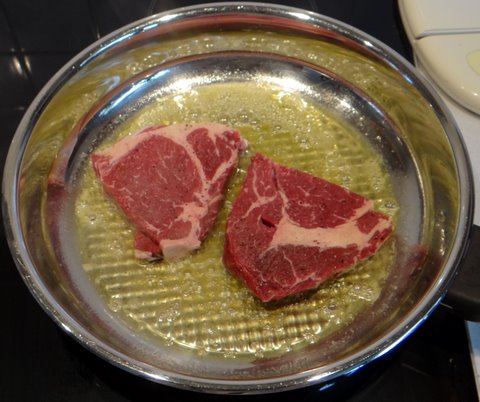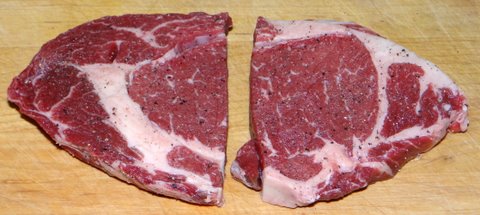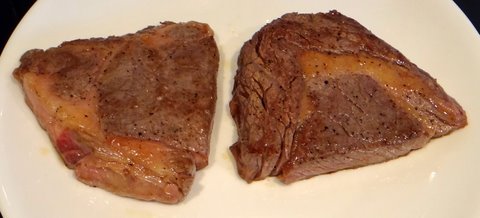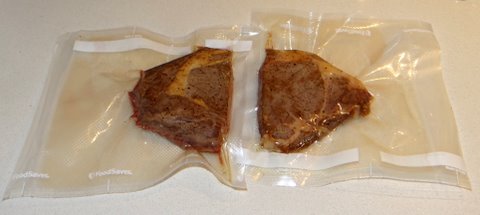Wow! I was reading the amazing set of books “Modernist Cuisine” by Nathan Myhrvold et al. and came across the suggestion (on page 3-78) to tenderize beef by boosting the activity of calpain and cathepsin enzymes in the meat through bringing the meat to temperatures of 39C/103F for calpains and 49C/120F for cathepsins. These are the same enzymes that are at work when meat is aged at refrigerator temperatures (both for dry ageing and for ageing in vacuum), but much faster and (compared to dry ageing) without drying the meat. Although it is described as a strategy to improve tenderness, it is not repeated in the “best bets for cooking meats sous vide” on pages 3-96 and 3-109.
I was intrigued about this enzymatic tenderization and decided to test it with a rib steak with some nice marbling that I had picked up. The steak was about 1/2 inch (12 mm) thick.
I cut the steak in half to cook one half in the normal way (only at 55C/131F) and the other half with the ‘warm ageing’ (my name for it) method. Since rib steak consists of different muscle groups with different tenderness to start with, I planned to compare the pieces next to the cut I had made. I seasons the steak with salt and freshly ground black pepper.

Then I seared both pieces briefly (30 seconds per side) in a hot frying pan with a mixture of butter and olive oil. This step is for adding a bit of flavor, but especially to kill any contamination on the surface of the meat. This is more important than usual, since half of the steak is going to be kept in temperatures that are not only good for enzymes but also good for bacteria.
I let the steaks cool down a bit on a plate.
Meanwhile, I sautéed a chopped shallot, a chopped clove of garlic, some thyme sprigs and a bay leaf in the remaining fat.
When the shallot was golden, I added some beef stock and let this simmer for a bit. (To make delicious red wine sauce, add red wine first and add beef stock after half the wine has evaporated.) After simmering to the desired thickness, I sieved the sauce to serve with the steak later.
When the steaks had cooled enough, I sealed them into individual pouches. So far, both halves have been treated exactly the same.
But now for the different treatment. One half was kept in the fridge, while the other half was first ‘cooked’ sous-vide for an hour at 39C/103F and then I increased the temperature setting to 49C/120F and kept it for another hour. Then I added the other pouch that had been kept in the fridge, and increased the setting to 55C/131F. Then I cooked for 2,5 hours to bring it to medium-rare/pink and pasteurize the meat for additional safety.
This is how the meat came out, with the ‘warm aged’ steak on the right-hand side. It seems that the ‘warm aged’ lost slightly more juicy, but it was not possible to taste any difference in that respect.
I took the steaks out of the pouches and added the juicy from the pouches to the sauce that was made earlier. I dried the steaks with paper towels, coated them with a thin layer of olive oil and gave them a brief (less than 30 seconds per side) sear on a very hot griddle. I then served them on hot plates with the sauce.
There was visually no difference, but the ‘warm aged’ steak was much more tender than the conventional sous-vide (that wasn’t bad either). I was pleasantly surprised by this difference and will from now on cook beef this way if I have the chance (since it does take two additional steps compared to the conventional way). To think this steak had only cost 4 euros, I don’t think I have ever tasted a steak that was so tender, so juicy and so tasty.
I suspect that this treatment will allow for shorter cooking times for tougher meat and thus make those more juicy as well, so more experiments to follow!










I think you have just earned the “meat geek” title!
LikeLike
Some of the Modernist Cuisine stuff is pretty geeky indeed. But I don’t care if it makes the meat so tasty!
LikeLike
That was supposed to be a compliment 🙂
LikeLike
Thank you. It’s certainly a lot better than “meat nerd” 😉
LikeLike
Do you think there would there be any point in trying this with steak that has already been cold aged (either wet or dry)? Would all the tenderization have already occurred during the cold ageing process, or can the steak be made even more tender even after say 28 days of dry ageing?
LikeLike
Cold ageing is much slower than warm ageing. Warm ageing after 28 days of cold ageing could still do somethng, but I’m not sure if you’d notice the difference as I haven’t tested that. I also found the warm aged beef to be juicier, that is not likely to happen with cold dry aged for 28 days, as that will be less juicy to begin with.
LikeLike
Stefan, would you consider repeating your experiment with a slight change? I suspect that the additional 2hr cooking time on the warm aged steak may have influenced the results, rather than the targeted 39C/49C treatment. I think the following experiment may yield a good comparison:
1) Cook steak A at: 39C – 1hr, 49C – 1hr, 55C 2.5hrs. Quick chill.
2) Cook steak B at 55C – 4.5hrs. Quick chill.
3) Bring both steaks to temp together.
While I think warm aging would definitely tenderize the meat, I wonder how different the results would be if they’re both given an equal amount of cooking time.
LikeLike
Thanks for your thoughts. I had thought of the caveat you point out and am planning to try something similar to what you are suggesting, but the problem is that it is impossible to really separate out the two effects because cooking for 1 hour at 55C or 1 hour at 39C makes a big difference. At 39C the enzymes are activated just like a cow having a fever. At 55C the meat is actually being cooked. But for 49C you are correct that there is some slow cooking going on that will influence the end result, and the experiment you suggest will give some more information to help separate the two effects. Perhaps I should cook steak B at 55C for 3.5 hours instead of 4.5 for a better comparison.
To be continued next time I feel like eating a rib steak…
LikeLike
Although dry aging reduces the amount of water in a steak, it also concentrates flavour and increases moisture retention during cooking. While ‘warm aging’ will certainly yield the tenderizing benefits of dry aging at a considerably accelerated rate, it will not develop the same flavour. During dry aging, enzymatic action in the muscle tenderizes the meat, and the open exposure allows it to oxidize. Although oxidation is generally an undesirable trait, the saturated fats in beef take particularly well to it; this in turn creates a nutty, blue-cheese like aroma and matures the flavour of the steak.
The benefits of tenderizing meat through traditional aging generally comes to a halt after 3 weeks. Meat-packers that dry age meat beyond this period do it for further flavour development. I do not think you would find any benefit to warm aging steak that has already been dry aged for 28 days.
LikeLike
Thanks for this informative response, which confirms my intuition.
LikeLike
Any more news or experiece with this exciting idea?
LikeLike
Thanks for visiting, hope you’ll become a regular here.
I’ve been using this technique on a regular basis for medium tender beef steaks after I’ve discovered it (i.e. cuts of beef that need more than just bringing up to temperature to become tender, but less than 48-72 hours like short ribs or chuck). I’ve also used it for leg of lamb (https://stefangourmet.com/2012/07/10/bbqed-lamb-skewers-with-balsamic-served-on-a-pink-piano/) and for sous-vide hamburgers (https://stefangourmet.com/2012/07/29/my-first-home-made-slow-food-hamburger/).
LikeLike
Does anyone know what one hour of warm aging equals in dry cold aging time ? Does one hour of warm aging equal twentyfour 24 hours?
LikeLike
I haven’t seen any literature on that. Dry aging takes about 4 weeks for any noticeable difference in tenderness, so I would imagine that one hour of warm aging would equal more than 1 day as the difference was noticeable after 2 hours of warm aging.
LikeLike
My goodness! I’ve just used this recipe for my very first attempt at sous vide cooking, using a PID temperature controller I’ve made myself.
I used a rather ordinary ‘riblap’, heating it to 39C / 49C / 55C exactly as indicated, then quickly searing it for 30 seconds on either side in a smoking hot skillet. It was heavenly!
This was exactly what I hoped for when I started building the PID device. Thanks for sharing this recipe, I’ll make sure to try your other recipes as well!
LikeLike
Hi Niels, that is great to hear! You picked a really good recipe for your first experiment with sous-vide cooking. There are many more sous-vide recipes on my blog and more to come. Let me know if you have any questions. Riblap is not the only humble piece of meat that becomes something special when cooked sous-vide. Impressive that you have built your own PID!
LikeLike
This is fascinating as riblap is normally considered a pretty tough cut of meat. I’m used to slow-braising it in the ‘English’ way with mushrooms and caramelised onions so that the fat renders and the visible connective tissue outside the muscle breaks down, but I’ll certainly try this.
LikeLiked by 1 person
Let me know how it turns out!
LikeLike
I can’t believe this is the first I’m hearing of this method, it makes so much sense !
I know most meat sold here commercially is already wet aged (cryovaced) but I’m very interested to see how much further it can be taken in the waterbath.
LikeLike
Thanks for visiting. I have much more sous-vide stuff on my blog.
If the meat you buy has already been wet aged at low temperature for a very long time, then I would not expect the warm aging to do a lot more as it is basically the same process at a higher temperature and thus a lot faster. (The only thing that I am not sure of is whether there is any process that won’t kick in until a certain temperature is reached.)
LikeLike
Stefan, would brining, before warm aging be of any benefit to further increase tenderness ?
LikeLike
Hi Chris, I am not a big fan of brining and only apply it when necessary. Brining does make the meat more juicy, but diluting the meat’s natural juices with salt water is not great for the flavor. Steak really doesn’t need brining. It might make the steak more juicy, but probably not more tender.
LikeLike
Damn it, I was hoping to get some work done today but now it looks like I will be reading every page of your blog 🙂
LikeLike
Thanks, ‘Ploppy’, for visiting my blog and taking the time to leave such nice comments.
LikeLike
Nice job! You did it way before me. I was searching for speeding up actions by calpain and cathepsin enzymes by warmer temperature, lo and behold, found your blog. Glad you did it! Wonder whether 1hr 39/1hr 49 is optimum. Also, did you try on pork? Again, thx for sharing your results. Good job!
LikeLike
Hi Weston,
Thanks for visiting and taking the time to leave such a nice comment.
I have not tried to optimize the times at 39 and 49 degrees, my thinking was to give both enzymes a chance for glory. Might be interesting to do experiments to find out. I haven’t tried this yet on pork.
LikeLike
I do the top sirloin cap (culotte) this way and then cook it 8 hrs at 134F.
I cool it down, put it in the refrigerator, then slice it into strips, skewer the whole cap and then sear. Great for French Dip sandwiches
I season it when I sear (not when I cook) and use the juices for the start of a sauce or au jus
Haven’t tried it yet but iI’d bet it would work well for brisket or flank steak
The extra cooking stages make a big difference. works great with rib eyes
LikeLike
Hi James, thanks for sharing your experience. I have tried it with hanger steak (works well) and rib eye (which I sear directly after the warm aging) but not yet with brisket or flank steak because of the long cooking times. It had not occured me yet to try that, but now I will as it may reduce the cooking time. Please report back here if you get there first.
LikeLike
This method works great for the tougher cuts. Sirloin and Tri-tip really respond well. It is my understanding that 39c and 49c are the upper limits for the calpains and cathepsins so I can at 37c and 47c each for 1-1.5 hours and then 55-56c for 4-6 hours.
Have also been doing much testing and research on Umami and Kokumi flavor enhancing and will share when I have it down. In the meantime, I highly recommend the book “Umami” by Ole Mouritsen.There are no recipes or formulas but you will have a very good understanding of how to incorporate umami compounds into your cooking, especially meats. It is amazing boost to flavor because they work on the taste buds,aking them more receptive to flavors
LikeLiked by 1 person
When cooking at such a low temperature for long lengths of time, aren’t you risking food poisoning? Granted you did sear the outside of the steak, but there is still a high risk when cooking under 130F. What are your thoughts on this?
LikeLike
Hi Tom,
According to FDA standards the risk of cooking under 130F is acceptable as long as it is for less than 4 hours. Also, when cooking intact muscle meat from a healthy farmed animal (i.e. not ground meat or pierced meat or game), any contamination will be on the outside of the meat and thus the searing would take care of that. I still won’t cook below 130F for more than 4 hours. Hope this helps!
LikeLiked by 1 person
Stefan,
I think you might have safety and cook temp/times a little confused. See http://www.fsis.usda.gov/Oa/fr/95033f-a.htm?redirecthttp=true for a fairly succinct table for combinations of temp/time that are safe. In fact, once the internal temperature of your meat reaches 130F, you need a cooking time of at least 121 minutes to safely pasteurize it. How long it takes before your meat reaches its internal temperature depends upon the size and cut of your meat. Pathogen growth stops at 52C or 123F. As most of the bacteria on a piece of meat (not shredded) lies on its surface, my guess is that as long as you cook the meat at a high enough temperature to stop pathogen growth, searing a piece of meat after a sous vide above 158F, to put this into perspective Maillard reaction occurs above 285F, will kill all surface bacteria almost immediately.
LikeLike
Hi Jack,
You are right that searing the meat will kill surface bacteria almost immediately. The reason why I say you shouldn’t ‘warm age’ the meat for too long is that if you first allow the bacteria to grow a lot (which is what will happen at temperatures below 52C/123F), then searing afterwards isn’t going to help anymore. And neither is pasteurization. It may not be the bacteria themselves that may get you sick (because they would be killed by the pasteurizing and/or searing), but the toxins they produced why they were still alive. Those toxins will not be destroyed by pasteurizing.
LikeLike
awesome results. We have used this method on flank steak,chicken wings, turkey legs, ham hocks, venison roasts, short ribs and half a dozen other meat cuts. Always get great results. Thanks for sharing.
LikeLike
Thanks so much for letting me know! I have never tried it on chicken yet myself.
LikeLike
I’m doing sous vide chicken wings this weekend.
I’m assuming you are frying or broiling them afterward
what is the time and temp you are using
Thanks
LikeLike
Chicken wings or drumsticks 4 hours at 64.5C/148F.
Broiling afterwards is great.
For frying, check this out: https://stefangourmet.com/2012/12/16/crispy-deep-fried-chicken/
LikeLike
Warm aging: 103F for 60 min, then 120F for 60 min – finally finished at 167F for 3 hours. Also used same for chicken legs [half the price this weekend @ 1.27 per lb.] both turned out really awesome, when deep fried start at 400 F and keeping temp above 350 F for 4 minutes. Tried using corn starch for the first time as a drying/dusting vapor/powder on half the wings and half the legs, and it worked very very well.
People commented that the corn starch dusted, were ‘crisper’, whatever that may means. Personal experience, do not assume that longer warm aging is better. Keep within the limits Kenji and those like minded had set. 1 to 1.5 hours. I ruined some beautiful pork belly while way outside the limits of that. LOL
Final note: Legs turned out to be more of a favorite that then wings. Comments were: ‘more meat’, ‘less work’, ‘better texture’ and ‘the best next day sandwiches ever.’ Made some spicy homemade mayo, fresh english cucumber pickles, and a touch of clear, spicy North Carolina Barbecue sauce. Put a dollop of sous vide cranberries on the side. Served on a ‘hoagie type’ Hawaiian bread baguette.
LikeLiked by 1 person
You just got linked as a reference from a BBC article! http://www.bbc.com/future/story/20150522-is-this-the-perfect-barbecue-method
LikeLiked by 1 person
Thanks for this post…I’d been searching for a way to use cheaper cuts of steak and still make them tender using Sous Vide, and this answered my question.
Do you know how much the warm aging time is dependent on the thickness of the steak? Texans like their steaks a bit thicker…an inch, or maybe even two…and I’m curious how much longer these would need to warm age.
Thx.
LikeLike
If the steak is really thick, it will take longer for the center of the steak to reach the ‘warm ageing’ target temperature, although of course the ‘warm ageing’ will already start as soon as it starts to heat up.
A steak of 1 inch thick takes about 30 minutes to reach the temperature, for 2 inches that is about two hours.
For food safety reasons it is not a good idea to ‘warm age’ the steak for longer than 3 hours. After those 3 hours, you should sear, rest, and eat it, or pasteurize it by increasing the temperature to 54.5C/130F for medium rare for at least 2 hours. The latter will also tenderize the steak even more, while keeping it at medium rare.
Hope this helps — let me know how it turns out or if you have any further questions.
LikeLike
Stefan,
Thanks for all the good info and testing.
Have you tried this or what are your thoughts:
Do the Wet Aging process, 2 hours at the lower temperature as a one-day or two-day prep step and put the steaks back into the refrigerator and then simply SV them to Medium or MRare a few days later. My thought is to tenderize early and save time on cooking/serving day.
Your Thought?
LikeLike
Hi Jean, there are some food safety concerns with that approach, as during the warm age as well as the cooling and reheating step bacteria can grow. I would recommend to pasteurize immediately after warm aging and then cool, refrigerate and reheat when needed. Depending on thickness, reheating will take a relatively short time. Once pasteurized, meat will keep for a long time in the refrigerator as long as it is vacuum sealed and your fridge is cold enough.
LikeLike
Stefan,
We more often find USDA Select (vs Choice or Prime) Beef where we live, Select is the least tender Beef cut. I assume the EU has a similar grading system. How long or how much longer would you cook a tougher Select Steak vs a Prime Steak to make it similarly tender. Would you double or triple the times, is there a rough formula that works. I think my wife and I would actually like the tougher cuts better because she wouldn’t need to cut away the fat sections while eating it and some of the tougher “dark meat” cuts are supposed to have more flavor even without the fat, right? Your thoughts…
LikeLike
Hi Jean, the best thing is to do a little experimenting, because it is hard to tell exactly how tender or tough your beef is and how tender you like it. Cut small (bite size) pieces of a steak and vacuum seal them individually. Then taste one after 2 hours at 55C/131F. If it is still a bit tough, try the next one after 4 hours. If it is still very tough, skip the 4 hour mark and wait for 6 or 8 hours. If you cook it for too long, the meat will have an unpleasant past like/powdery consistency. The tougher dark meat cuts like short ribs have more flavor because they have more collagen that will melt into gelatin. However the conversion of collagen into collagen will take so long at 55C/131F that if there is too much of it, the nice meat will be overcooked by the time the connective tissue has broken down. If that is the case, you may prefer to cook 24 hours at 74C/165F to get a stewed/braised/pullable texture. Hope this helps and let me know if you have any follow up questions.
LikeLike
I discovered this premise after I had bagged two 2′ thick steaks…
Instead of searing, I boiled some water turned it off and let it fall back just below boiling. Then I tossed them in for about a minute each. Haven’t tried them yet, but I’m hoping that will have killed any remaining active germs the same way searing would have… it was just enough to see the surface shift toward gray brown. just dropped them in at 103. Let’s see how it goes…
LikeLiked by 1 person
I recently did another post on warm aging and used the same method to kill the ‘germs’ that may be on the surface before warm aging: https://stefangourmet.com/2018/04/30/sous-vide-warm-aging-revisited/. A minute is plenty, at 100C/212F those germs will die in less than a second (but I usually apply 10 to 30 seconds to make sure that the heat has penetrated far enough).
Let me know how it turns out!
LikeLike